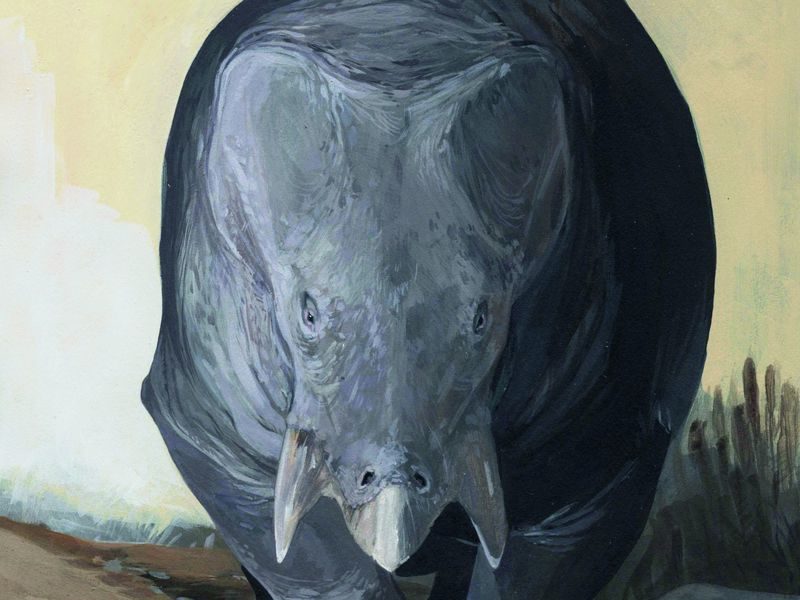
© (Karolina Suchan-Okulska)Dicynodont
During the age of the dinosaurs, the story often told is that the thunder lizards ruled the earth, growing to the size of cars and busses while the ancestors of mammals and other animals were tiny little insect-eating fuzzballs, scurrying around during the night to avoid the reptilian teeth. But the fossil of an African elephant-sized creature found in southern Poland upends that narrative, reports Gretchen Vogel at
Science magazine.
The beast, named Lisowicia bojani, looked something like a cross between rhinoceros and a turtle, weighing in at nine tons. The creature is a dicynodont, one of the first groups of animals to eat plants. It's also part of a broader group of creatures called synapsids, which includes the direct ancestors of mammals, making it something of a cousin to the earliest mammal ancestors, or proto-mammals. The most intriguing thing about the creature, however, is that
it dates to the Late Triassic period about 201 to 240 million years ago when dinosaurs first began their reign. It was believed that by that period most other creatures had shrunk in size to hide from the giants, including dicynodonts, which maxed out at the size of a dog, but
L. bojani shows that's not the case. The research appears in the journal
Science.
Stephen Brusatte, a vertebrate paleontologist at the University of Edinburgh not involved in the study, tells George Dvorsky at
Gizmodo that the find is a big deal.
"Before these giant bones were discovered, you would have been called crazy if you ever suggested there were giant, elephant-sized mammal cousins living alongside some of the very first dinosaurs," he says. "We used to think that after the end-Permian extinction [252 million years ago], when some 90-95 percent of all species went extinct, mammals and their relatives retreated to the shadows while dinosaurs rose up and grew to enormous sizes. That's the story I tell my students in my lectures. But this new discovery throws a wrench into that simple tale."
Since 2005, researchers have been pulling fossil bones out of a clay pit in Lisowice, Poland, and in 2008, they found a 22-inch dicynodont femur, which was their first hints that big animals were in the pit. The latest find included a considerably larger 31-inch femur, one of 1,000 bones uncovered during 11 years of fieldwork at the site. In total, reports John Wenz at
Popular Mechanics, the team
found about 70 percent of the animal's bones, giving them incredible insight into the beast.
Fossils found along with the 8.5-foot tall, 15-foot-long dicynodont indicate that it
likely lived on a wide, flat riverside eating seed-ferns and early tree-like plants called Brachyphyllum. The team also found the fossils of tiny shrew-like proto-mammals that would have scurried below its feet and fossils from predatory dinosaurs in the same location.
The fossil raises lots of questions, and researchers
aren't even sure if the animal they found is a fully grown since the bones didn't show signs of slowing growth, meaning there could be even larger specimen out there. It raises questions about why animals in this period grew so ginormous, and why the dinos eventually won out. "The discovery of
Lisowicia changes our ideas about the latest history of dicynodonts, mammal Triassic relatives," co-author Tomasz Sulej of the Polish Academy of Sciences says in a press release.
"It also raises far more questions about what really make them and dinosaurs so large." One prevailing theory is that sauropods and other huge dinosaurs evolved their massive size to avoid getting eaten by carnivorous predators, something that may have been at play with
L. bojani as well, reports Vogel at
Science. The team hopes to look next in Russia and Ukraine to see if there is more evidence that other massive dicynodonts once walked the earth.
Comment: There seems to be a relentless stream of recent discoveries throwing many of the mainstream theories of evolution into disarray:
- Stone tools put early hominids in China 2.1 million years ago - 250k earlier than previously thought
- Study suggests multiple episodes of inter-breeding between Neanderthal and humans
- Extinct Denisovan people may have colonized Earth's highest plateau in Tibet 30,000 years ago
Could perhaps part of the reason for their massive size be due to the planet harboring a very different environment than it does today?- The Golden Age, Psychopathy and the Sixth Extinction
- "The entire Earth moved": True polar wander and how Hawaiian hot spots show Earth has shifted on its axis
- Mammoth site is over 100,000 years older than previously thought - And the climate was warmer than it is today
- New giant dinosaur species discovered in Argentina
- Russian archaeologists discover new species of 10-ton, 40-foot dinosaur in Siberia
Also check out SOTT radio's: The Truth Perspective: Are Cells the Intelligent Designers? Why Creationists and Darwinists Are Both Wrong